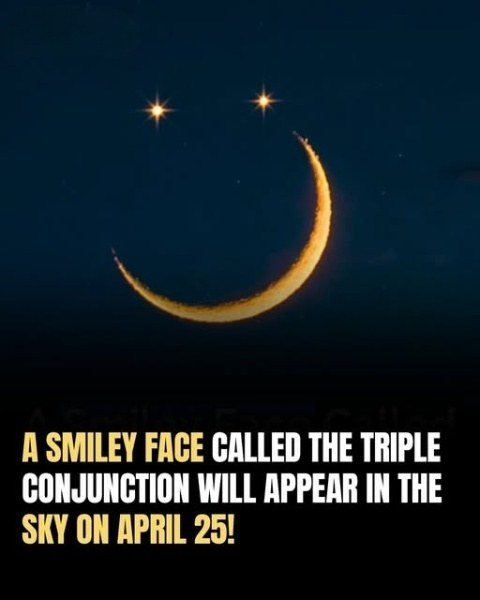Skywatchers around the world should prepare for a truly special event on April 25, 2025, when the crescent moon, Venus, and Saturn will align in a way that creates what astronomers affectionately call a “cosmic smile” in the predawn skies, a rare formation that anyone with a clear view of the eastern horizon can enjoy without needing specialized equipment or perfect conditions.

While planetary alignments are not uncommon, ones that form recognizable patterns like a smiley face are rare and captivating, making this a moment not to miss. During this particular triple conjunction, Venus will shine brilliantly as one “eye” higher up, Saturn will glow just below as the second “eye,” and the delicate crescent moon will arc beneath them, completing the joyful face. NASA Solar System Ambassador Brenda Culbertson explained to KSNT that Venus would be higher above the eastern horizon, Saturn a bit lower, and the crescent moon a little further north, collectively resembling a smile to observers.
From our perspective on Earth, Venus appears as a dazzling white point, about 25 times brighter than Saturn, while Saturn’s muted golden hue makes it stand out even though it’s dimmer, and because planets appear only as bright points without expanding into visible discs to the naked eye, both will twinkle sharply against the backdrop of the sky. The best time to catch this delightful spectacle will be around 5:30 a.m. local time, about an hour before sunrise, giving viewers a narrow window to enjoy the event, so early preparation is key, and arriving a little ahead of time allows eyes to adjust naturally to the darkness for the clearest view.
Thanks to its global visibility, anyone with a clear eastern horizon can see it, though city dwellers might find tall buildings challenging, making rural or higher-altitude spots far more ideal. There’s even a chance that Mercury might be spotted lower on the horizon for those with especially clear conditions, a bonus treat beyond the main cosmic smile. Choosing a good viewing location is crucial, with the best sites being free from obstructions like trees, hills, or buildings, such as open fields, elevated areas, or east-facing beaches. Light pollution can greatly diminish the experience, so heading away from city lights is recommended, and resources like online light pollution maps can help identify the best nearby spots. Checking the weather forecast the day before is also essential because even thin clouds can obscure the view, and it’s wise to have a backup plan in case conditions change overnight.
Depending on your region in North America, specific recommendations include beaches facing the ocean on the Eastern Seaboard, wide-open rural spaces in the Midwest, eastern-facing slopes in the Mountain States, and highlands overlooking valleys on the West Coast. While you don’t need fancy gear to enjoy the event, a simple pair of binoculars, such as 7×35 or 10×50 models, can dramatically enhance the experience by revealing the fine details of the moon’s surface and helping to distinguish the planets more clearly. Amateur telescopes can take it further, showing Saturn’s rings, Venus’s phases, and even more lunar details, especially since Mars will also be particularly visible later in the month during its opposition. Smartphone apps like Stellarium, Sky Guide, or NASA’s Sky Watch can be very helpful, using GPS and orientation to pinpoint planets quickly, so testing the app ahead of time is a smart move. Families can make the viewing memorable by preparing in advance, explaining the event to children with simple, relatable comparisons, such as describing Saturn as a bead and Venus as a marble from Earth’s point of view, and planning fun activities like drawing the cosmic smile afterward or trying basic stargazing photography. Make sure to dress warmly, bring folding chairs, warm drinks, and use red-filtered flashlights to preserve night vision. Photography enthusiasts should mount their phones or cameras on tripods, use timers or voice commands to avoid blurring, set the focus to infinity, and experiment with exposure settings, while DSLR or mirrorless camera users should aim for wide apertures, ISO settings between 800 and 3200, and exposure times around 5 to 15 seconds to balance clarity and brightness. Post-processing can help enhance captured images by adjusting contrast, recovering shadows, and stacking multiple exposures to increase sharpness and detail. Besides the cosmic smile, April 2025 brings other spectacular sky events, including the Lyrid meteor shower peaking around April 21-22 and Mars reaching opposition on April 19, offering even more opportunities for stargazing. Spring constellations like Leo, Boötes, and Virgo will grace the evening skies in the Northern Hemisphere, while Southern Hemisphere observers can enjoy stunning views of the Southern Cross and Centaurus. The International Space Station will also make several visible passes throughout the month, appearing as a bright, moving point of light in the early morning or evening sky. So don’t miss this rare opportunity on April 25, when Venus, Saturn, and the crescent moon will create a dazzling cosmic smile, visible around 5:30 a.m. with just your eyes and a bit of preparation. Choose a good spot facing east, set your alarm early, check the weather, and make it an unforgettable morning of wonder with your family or friends as you share a smile not just with each other, but with the universe itself.





